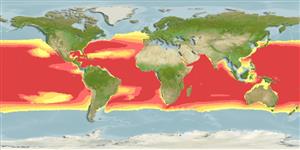Teleostei (teleosts) >
Aulopiformes (Grinners) >
Giganturidae (Telescopefishes)
Etymology: Gigantura: Latin, gigas, giganteum = giant + Greek, oura = tail (Ref. 45335).
Issue
Genus B. Mundy, pers. comm.
Environment: milieu / climate zone / depth range / distribution range
Ecology
Marine; bathypelagic; depth range 17 - 2100 m (Ref. 58302), usually 500 - 2000 m (Ref. 58302). Deep-water
Circumglobal: In tropical to subtropical waters. Deep sea.
Size / Weight / Age
Maturity: Lm ? range ? - ? cm
Max length : 26.0 cm TL male/unsexed; (Ref. 121807)
Meso- and bathypelagic (Ref. 58302). The species is rare. Inhabits deep water. Famous for its bizarre shape and unusual eyes.
Life cycle and mating behavior
Maturity | Reproduction | Spawning | Eggs | Fecundity | Larvae
Johnson, R.K. and E. Bertelsen, 1991. The fishes of the family Giganturidae: systematics, development, distribution and aspects of biology. Dana Rept. No. 91:1-45. (Ref. 7449)
IUCN Red List Status (Ref. 130435: Version 2024-1)
Threat to humans
Harmless
Human uses
Fisheries: of no interest
Tools
Special reports
Download XML
Internet sources
Estimates based on models
Preferred temperature (Ref.
123201): 2.4 - 9.4, mean 4.1 °C (based on 3607 cells).
Phylogenetic diversity index (Ref.
82804): PD
50 = 1.0000 [Uniqueness, from 0.5 = low to 2.0 = high].
Bayesian length-weight: a=0.00102 (0.00046 - 0.00225), b=3.06 (2.88 - 3.24), in cm total length, based on all LWR estimates for this body shape (Ref.
93245).
Trophic level (Ref.
69278): 4.0 ±0.7 se; based on size and trophs of closest relatives
Generation time: 1.3 ( na - na) years. Estimated as median ln(3)/K based on 1
growth studies.
Resilience (Ref.
120179): Medium, minimum population doubling time 1.4 - 4.4 years (Assuming tmax>3).
Fishing Vulnerability (Ref.
59153): Low vulnerability (17 of 100).
